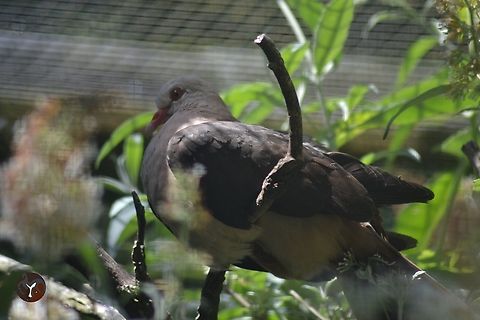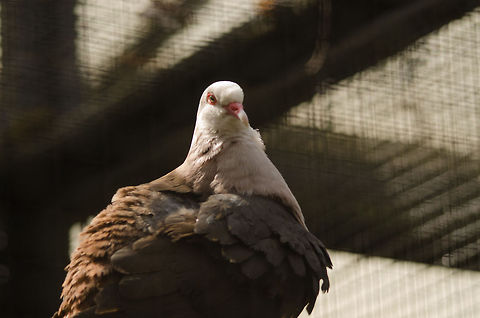
Appearance
An adult pigeon is about 32 centimetres from beak to tail and 350 grams in weight. Pink pigeons have pale pink plumage on their head, shoulders and underside, along with pink feet and pink beak. They have dark brown wings, and a broad, reddish-brown tail. They have dark brown eyes surrounded by a ring of red skin.Newly hatched pigeons have sparse, downy-white feathers and closed eyes.

Habitat
On Mauritius, it is found in patches of forest in the national park region of the southwest, as well on Ile aux Aigrettes, a nature reserve off the southeast coast of Mauritius. Further plans for released populations in the east coast mountains are under way.It prefers upland evergreen forests, but is equally at home in coastal forest as long as the vegetation is natural and not smothered by introduced species, such as guava or privet. Destruction of these forests have been a major reason for its decline.

Reproduction
The breeding season starts in August–September, although birds may breed all year round. The male courts the female with a "step and bow" display. Mating is generally monogamous, with the pair making a flimsy platform nest and defending a small area around it. The female usually lays 2 white eggs, and incubation duration is 2 weeks. The male incubates during the day, and the female during night and early day. They breed very often. They lay 5 to 10 eggs in a season. Pausing in the wild only whilst in moult. They either go through a full moult or a head moult.In captivity, males remain fertile till 17 – 18 years of age, females till 10 – 11 years of age.
1 – 7 days: Chicks eyes closed, fed entirely on crop milk.
7 – 10 days: Chicks undergo a dietary transformation to solid food.
2 – 4 weeks: Chicks fledge, but are parent-fed.
4 - 6/7 weeks: Chicks remain in the nest. After this the chicks leave the nest.
Food
It feeds on native plants - by consuming buds, flowers, leaves, shoots, fruits and seeds as well as insects. Non-native species like guava pose a threat to it by preventing growth of native trees. It does supplement its diet at feeding stations manned by conservation officials.Predators
Habitat degradation, introduced mammalian predators and wildlife disease are ongoing threats to the pink pigeons survival. Only 2% of native forest remains in Mauritius, the majority on upland slopes around the Black River Gorge National Park. Active management of these threats, supplementary feeding and habitat restoration are key factors in the recovery of this species.References:
Some text fragments are auto parsed from Wikipedia.